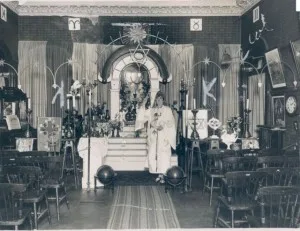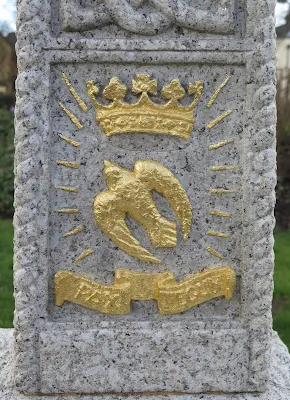It is only within the last few years that I discovered the identity of RR Skinner’s mother, of whom he spoke only with affection. The Skinner family is represented on the Find a Grave website and without this resource I would not have found Mrs. Skinner, who was a well-known spiritualist in Bethnal Green in London in the 1920s. Spiritualism was very popular in the 19th Century, it affirmed that communicating with the dead was possible, and, for instance, Sir Arthur Conan Doyle, among others, were spiritualists. "The Mother", as Elizabeth Mary Eagle Skinner was referred to, had a North American indigenous spirit guide, that is, the "person" whose messages were communicated by her was a native American; however, she was not the only medium with a North American native guide, there are others. We have an Indigenous People's television network here in Canada and one of their programmes is Spirit Talker which features a medium, a First Nations' spiritualist, who sits with other natives, average people, and communicates what their deceased relatives want to say to them; some of these episodes are highly moving; I expect that this was the type of thing done by Elizabeth Mary Eagle Skinner, it is to "deliver a message of hope, healing, and closure."
I suspect that Mrs. Skinner may have borrowed from several occult traditions, including the Rosicrucians and the Theosophists. She doesn't seem to have written any books or articles on this subject, subsequently there is little evidence for what she said or did in life. RR Skinner was both her son and pupil in the art or practise of psychic reading. Here is something of what we know:
Elizabeth Mary Ann Eagle Skinner
 |
| Mrs Elizabeth Mary Eagle Skinner of The Universal Brotherhood, the Mystical Church of the Comforter |
Mrs Elizabeth Mary Eagle Skinner of The Universal Brotherhood, the Mystical Church of the Comforter with headquarters in a church (a disused waiting room ) at Denmark Hill Station; “The leader and founder of the church was Mrs. Elizabeth Skinner, whose official title was The Messenger…” (1 January 1927)
Excerpt for Wikipedia entry on the location of Mrs. Skinner’s church at the Denmark Hill railway station:
The station was built between 1864 and 1866. Its design by Charles Henry Driver is in the Italianate style, with an extremely decorative frontage and French pavilion roofs.[4]
... In 1920 the waiting room was used by The Mystical Church of the Comforter, founded by Elizabeth Mary Eagle Skinner, who was known as "The Messenger". The waiting room was transformed by an altar, painted white and surrounded by the seven colours of the rainbow.[5] The Nottingham Evening Post for 17 June 1926 reported that babies were baptised, funeral services were read and even a marriage was solemnised. The porters and clerks of the railway company often worked to the accompaniment of hymns sung by the congregation. The church is believed to have ceased to function after the death of Skinner in November 1929. . . By the late 1970s, the structure had fallen into disrepair...
-o-
1920 saw the station’s waiting room commence use by The Mystical Church of the Comforter, founded by Elizabeth Mary Eagle Skinner who was affectionately known as ‘The Messenger’. This arrangement lasted until Skinner’s death in November 1929.
--https://blog.lessavine.co.uk/denmark-hill-station-dmk/
-o-
The following is from https://loughborough-junction.org/2016/12/01/the-mystical-church-of-the-comforter-in-denmark-hill-railway-station/
Mrs Skinner passed away on November 24, 1929 and this report from the Lancashire Evening Post, 27 November 1929, describes the scene. She is buried in Camberwell Old Cemetery.
The Mystical Church of the Comforter … in Denmark Hill Railway Station
A disused waiting room in Denmark Hill Railway Station hosted the Mystical Church of the Comforter. It’s founder was Elizabeth Mary Ann Eagle Skinner nee Roberts. She was born August 30-31, 1875 in Bethnal Green. She married Arthur John Skinner, who was a teacher at Alleyn’s Dulwich.
She founded the Church in 1901 and it moved into the disused waiting room next to the ticket office at Denmark Hill around 1920.
The church in the station: http://jot101.com/2019/10/the-church-in-the-station/
If you were catching a train to or from Denmark Hill railway station in Camberwell, London, any time between 1920 and 1929 you might be surprised to find that one of the waiting rooms there had been converted to a place of worship. But not any place of worship. Around 1920 a disused waiting room on the first floor was let to one Mary Elizabeth Eagle Skinner for use as a temple dedicated to her Mystical Church of the Comforter, a religious foundation, which she claimed had ancient foundations, but which she had re-established in 1901.
Little is known about Mary Skinner (1875 – 1929) apart from the fact that she was a Rosicrucian of the Ymir Temple, was married to a schoolteacher, called herself ‘The Messenger', but was popularly known as 'mother'. Her full-page advert in the April 1926 issue of The Occult Review which we found at Jot HQ recently, tells us a little more about the teachings of her Church, which were no doubt laid down by herself, she being to all intents and purposes a one-woman band.
One curious newspaper reporter in 1926 described the Temple thus:
One end of the room had been transformed into an altar, painted white and surrounded by the seven colours of the rainbow. Seven steps lead up to the altar, and at the side are two pillars representing Beauty and Strength. Everything is done by symbols, and the badge worn by members is a dove standing in the circle with a seven-leaved branch in its beak.
Skinner was not the first religious figure to proclaim the importance of ‘Universal Brotherhood’, but unlike most established religions around the world, she supported the idea that men and women are equally qualified to act as ministers. The chief teachings had aspects in common with orthodox Christianity, although the emphasis was much more on the unity of all ‘men, of all creeds, seeing the one Eternal LIGHT of LOVE shining through all ‘. There is also an emphasis on the importance of personal moral responsibility:
‘Thou art thy own judge; thy conscience tells thee. There is no such thing as a bad conscience : it is thy good conscience that reproves thee. Thy conscience is the EYE of the soul. It is the Angle with the Flaming Sword !
Such teachings recall those of the Ba’hai movement, which was founded in the 1840s, and which claims to be the youngest major religion in the world. Skinner may have been influenced by the teachings of the Ba’hai leader, who toured England in the early years of the twentieth century.
Services at the Mystical Church were held on Sunday, Wednesday and Thursday evenings (presumably when the station was less busy). Healing took place on Saturday evenings and ‘deeper‘ sessions were available to enrolled members only on Monday and Friday evenings.
It would be interesting to know what sort of people attended Skinner’s services, but whoever they were, most seem to have flocked to the Temple to see her body laid out following her death in November 1929 at the early age of 54. Indeed there was such a crush in the passage outside the former waiting room, that there were fears for the safety of all concerned. One admirer of ‘mother‘ Skinner summed up the feelings of all who knew her:
‘She was a great and loving soul, a prophetess and a seer…’
--R.M.Healey
One end of the room has been transformed by an altar, painted white and surrounded by the seven colours of the rainbow. Seven steps lead up to the altar, and at the side are two pillars representing beauty and strength. Everything is done by symbols, and the badge worn by the members is a dove, standing in a circle with a seven-leafed branch in its beak.
--A description from the Lincolnshire Echo, 21 August 1926
“The leader and founder of the church is Mrs Elizabeth Mary Eagle Skinner. Her official title is “The Messenger” but most of the members call her Mother. When conducting a service, Mrs Skinner wears white robes ornamented with mystical signs. She is a Rosicrucian and the signs used refer to some of the inner orders of that society.”
-o-
The church was mentioned in an advertisement published in a periodical “Review, THE PROBLEM OF ATLANTIS”; note: this periodical seems to have published only advertisements.Messenger (YMIR TEMPLE) Elizabeth Mary Eagle Skinner. 'Phone Brixton 2426. A BOOK OF GREAT INTEREST. The Problem of Atlantis. By LEWIS SPENCE. Demy 8vo, cloth Source: http://www.iapsop.com › materials › occult_review
-o-
 |
| Mrs. Skinner at the altar of her temple |
 |
| The symbolism of Mendelssohn's Wedding March played at a funeral... now wed to eternity. |
 |
| Statement by Elizabeth Mary Eagle Skinner |
 |
| Newspaper report of Elizabeth Mary Eagle Skinner funeral |
https://harveymorris.uk/2020/10/29/covid-nights-a-storm-over-haunted-camberwell/



No comments:
Post a Comment